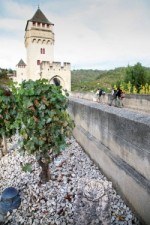History of the pilgrimage
Cahors, a major stage on the way to santiago de compostela

In the Middle Ages, the pilgrimage to Saint James (Santiago) of Compostela was one of the three major pilgrimages that every good Christian was expected to undertake, along with those to Rome and Jerusalem.
From the ninth century, pilgrims had been visiting visit the tomb of the apostle Saint James, discovered by a hermit who was guided to "Field of the Star" or "Campus Stellae."
Pilgrims from four corners of Europe left their homes, on their way to Galicia. For practical and safety reasons, they eventually converged on specific routes and meeting places, notably Paris, Vézelay, Arles and Le Puy en Velay.
These Chemins de Compostela were first designated as "European Cultural Routes" by the Council of Europe in 1987. In 1998, UNESCO in turn recognised the outstanding universal value of the paths by placing 71 buildings and 7 sections of the route from Le Puy en Velay on the World Heritage List.
A pilgrimage, a spiritual path and meeting places, the Way of Saint James — Santiago de Compostela — has risen dramatically in popularity over the last few decades and continues to do so.
Cahors is crossed by the Via Podiensis, the route from Puy en Velay, today called the Grande Randonnée route GR65. The city of Cahors and the Grand Cahors area are also at the crossroads of several variants: the GR651 variant through the Célé valley and the GR46 variant from Rocamadour. It is an important stage for pilgrims and hikers today.
Two monuments in Cahors are listed as World Heritage by UNESCO on the pilgrimage way: the famous Pont Valentré bridge and the Cathedral of St Etienne.


